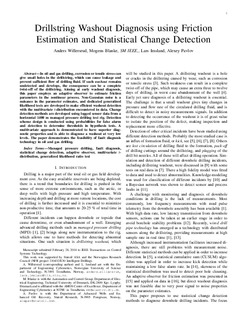| dc.contributor.author | Willersrud, Anders | |
| dc.contributor.author | Blanke, Mogens | |
| dc.contributor.author | Imsland, Lars Struen | |
| dc.contributor.author | Pavlov, Alexey K. | |
| dc.date.accessioned | 2015-01-19T10:19:01Z | |
| dc.date.accessioned | 2016-10-19T13:52:13Z | |
| dc.date.available | 2015-01-19T10:19:01Z | |
| dc.date.available | 2016-10-19T13:52:13Z | |
| dc.date.issued | 2015 | |
| dc.identifier.citation | IEEE Transactions on Control Systems Technology 2015 | nb_NO |
| dc.identifier.issn | 1063-6536 | |
| dc.identifier.uri | http://hdl.handle.net/11250/2416428 | |
| dc.description.abstract | In oil and gas drilling, corrosion or tensile stress can give small holes in the drillstring, which can cause leakage and prevent sufficient flow of drilling fluid. If such \emph{washout} remains undetected and develops, the consequence can be a complete twist-off of the drillstring.
Aiming at early washout diagnosis, this paper employs an adaptive observer to estimate friction parameters in the nonlinear process. Non-Gaussian noise is a nuisance in the parameter estimates, and dedicated generalized likelihood tests are developed to make efficient washout detection with the multivariate $t$-distribution encountered in data. Change detection methods are developed using logged sensor data from a horizontal 1400 m managed pressure drilling test rig. Detection scheme design is conducted using probabilities for false alarm and detection to determine thresholds in hypothesis tests. A multivariate approach is demonstrated to have superior diagnostic properties and is able to diagnose a washout at very low levels. The paper demonstrates the feasibility of fault diagnosis technology in oil and gas drilling. | nb_NO |
| dc.language.iso | eng | nb_NO |
| dc.publisher | Institute of Electrical and Electronics Engineers, IEEE | nb_NO |
| dc.title | Drillstring Washout Diagnosis using Friction Estimation and Statistical Change Detection | nb_NO |
| dc.type | Journal article | nb_NO |
| dc.type | Peer reviewed | nb_NO |
| dc.date.updated | 2015-01-19T10:19:01Z | |
| dc.source.pagenumber | 1886-1900 | nb_NO |
| dc.source.volume | 23 | nb_NO |
| dc.source.journal | IEEE Transactions on Control Systems Technology | nb_NO |
| dc.source.issue | 5 | nb_NO |
| dc.identifier.doi | 10.1109/TCST.2015.2394243 | |
| dc.identifier.cristin | 1200676 | |
| dc.relation.project | Norges forskningsråd: 223254 | nb_NO |
| dc.description.localcode | © 2015 IEEE. This is the authors' accepted and refereed manuscript to the article. Personal use is permitted, but republication/redistribution requires IEEE permission. | nb_NO |
